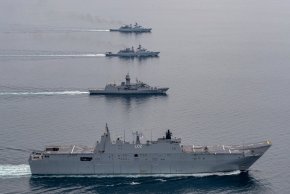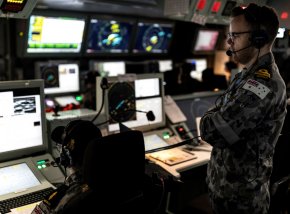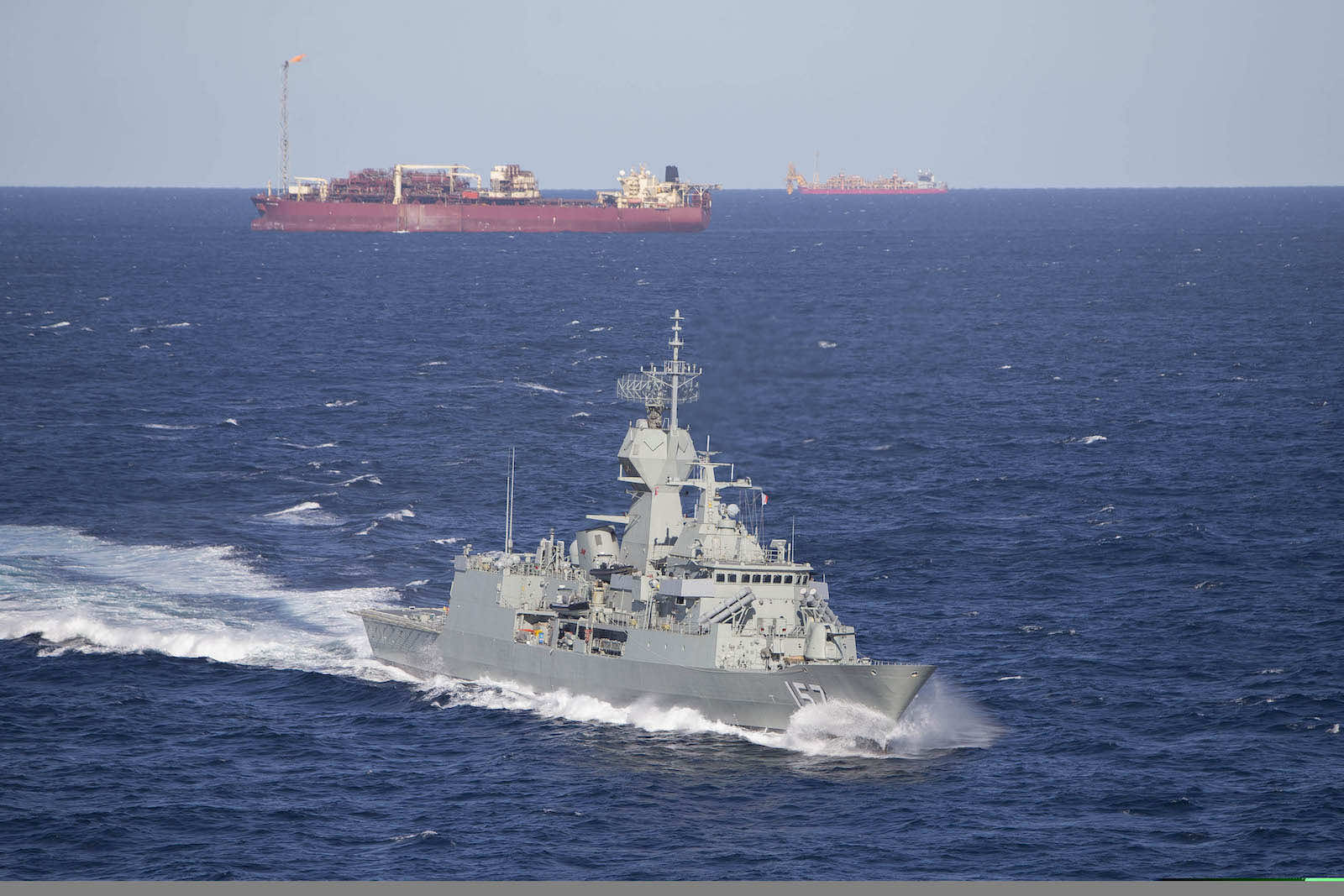Royal Australian Navy Discussions and Updates
- Thread starter icelord
- Start date
- Status
- Not open for further replies.
Actually the PSV might be an interesting ship to train and crew with a part Pacific crew. Fiji and Timor were complaining about how limited it was to get training. Why not make the ship part of the training solution? IMO you will get much better mileage out of the program if it is more joint nation, rather than AU exclusive.
They may use the Teekay option as with the ADV Ocean Protector. Civilian crew operate the ship but with defence folk embarked for the specific mission. Recognition of sea time for commercial qualifications should be practical under those conditions if cadets/seaman trainees are contemplated.Actually the PSV might be an interesting ship to train and crew with a part Pacific crew. Fiji and Timor were complaining about how limited it was to get training. Why not make the ship part of the training solution? IMO you will get much better mileage out of the program if it is more joint nation, rather than AU exclusive.
Always liked Pacific Islander crews on ships. In my time in the Merchant Marine (British) we used Tuvaluan and PNG (from Milne Bay) crew on many of our ship. They were very good. The PNG were directly employed by the company and were well looked after. Resulted in a very motivated crew.
Back to the topic at hand... again the lack of clarity on how this ship will operate means we are all guessing.
I think that would be a better idea. To give smaller island nations their own HADR capability would be a more effective way of dealing with region wide disasters such as cyclones, as well as taking care of those smaller tasks that wouldn't normally be seen as a priority.These thoughts highlight perhaps a better way of engaging with the Pacific Island nations than has been done in the past. I have read somewhere that some of the PIF countries have suggested that they would prefer to receive vessels that would enable them to connect more frequently with their many outlying islands, as a higher priority, rather than the Guardian class patrol boats. Ultimately the GoA and the various departments involved in various nation building projects need to listen to the various Pacific Island governments rather than dictating what the 'solution' that will be provided.
As the PSS/PSV envisaged above is not a warship, then it should be able to be constructed to civilian standards and largely crewed by civilian sailors. It might even be a useful training environment for trainees and graduates of the AMC.
However the cynic in me thinks that this might be as much about showing the flag and winning the hearts and minds of the locals as anything else and a big ship moored in the harbour is a more attention grabbing way of doing that.
No need to be cynical. It was first suggested as a counter to Chinese influence, a strategy that goes back beyond the classical GreeksHowever the cynic in me thinks that this might be as much about showing the flag and winning the hearts and minds of the locals as anything else and a big ship moored in the harbour is a more attention grabbing way of doing that.
oldsig
Meanwhile in the working Navy :
"HMAS Canberra and Anzac with Royal Malaysian Navy ships KD Jebat and KD Lekui, sail in formation during Indo-Pacific Endeavour 2021."
Image source : ADF Image Library

"HMAS Canberra and Anzac with Royal Malaysian Navy ships KD Jebat and KD Lekui, sail in formation during Indo-Pacific Endeavour 2021."
Image source : ADF Image Library

I take it that the design team for the Anzac upgrades were Dr Who fans? Nice bit of homage there, though I suppose the Malaysians probably did get the pop culture reference. 
It actually looks more phallic than dalek.I take it that the design team for the Anzac upgrades were Dr Who fans? Nice bit of homage there, though I suppose the Malaysians probably did get the pop culture reference.
Now you can never unsee it.
Redlands18
Well-Known Member
Exterminate, Exterminate, ExterminateI take it that the design team for the Anzac upgrades were Dr Who fans? Nice bit of homage there, though I suppose the Malaysians probably did get the pop culture reference.
Redlands18
Well-Known Member
Nuship Stalwart formally accepted on 30 Aug.
Sneak peak into the modern ops room, big screens and colour displays, slightly different to the old yellow CRT displays of days past. 
HMAS Warramunga's operations room team conduct an Air Defence Exercise during AUSINDEX 21. Image source - ADF Image Library

HMAS Warramunga's operations room team conduct an Air Defence Exercise during AUSINDEX 21. Image source - ADF Image Library

Will she be based in WA?Nuship Stalwart formally accepted on 30 Aug.
Regards,
Massive
An interesting article from the Lowy Institute that discusses the concepts of SLOC and sea control. The author discusses in wartime what are you protecting on your SLOC? Trade or essential supplies? Secondly, WRT sea control, how much sea are you attempting to control and for how long? What's the purpose of it? Thirdly WRT to both concepts what's best in the national interest during wartime, and how do we prepare for it now? How quickly do we need to prepare? Lots of very important questions to answer and they all relate to National Security Strategy, especially resilience.

 www.lowyinstitute.org
www.lowyinstitute.org

Australia’s essential need: not seaborne trade but seaborne supply | Lowy Institute
“Sea control” is not about dominating waters but only to the extent necessary to ensure the movement needed.
Yes, that’s the plan - one on each coast.Will she be based in WA?
Regards,
Massive
Thanks Spoz.Yes, that’s the plan - one on each coast.
A long way away but will be interesting to see how basing plays out when/if the JSS come into service.
Would both supply ships end up at FBW & the JSS at FBE.
Regards,
Massive
I would imagine one AOR and one JSS at each coast.
FBE has the LHD, the Hobarts and what ever else is around.
FBE has the LHD, the Hobarts and what ever else is around.
Just wondering re Nuship Stalwart.Nuship Stalwart formally accepted on 30 Aug.
It has been accepted, but has it being commissioned into the RAN?
Is there a difference or just different terminology for the same outcome.
Regards S
Yes, there is a difference. The CoA has accepted the ship from the prime contractor; there follows a certification and training period before the mariner skills evaluation. Commissioning is usually just before that, some weeks after delivery. Although it does mark the point where “NUSHIP” becomes “HMAS”, it is largely ceremonial.
Redlands18
Well-Known Member
Unfortunately its likely to be another low key commissioning, may even do it at sea again like the Sydney, though being in Perth may help with how many people can be there.Yes, there is a difference. The CoA has accepted the ship from the prime contractor; there follows a certification and training period before the mariner skills evaluation. Commissioning is usually just before that, some weeks after delivery. Although it does mark the point where “NUSHIP” becomes “HMAS”, it is largely ceremonial.
Thanks for the clarityYes, there is a difference. The CoA has accepted the ship from the prime contractor; there follows a certification and training period before the mariner skills evaluation. Commissioning is usually just before that, some weeks after delivery. Although it does mark the point where “NUSHIP” becomes “HMAS”, it is largely ceremonial.
Cheers S
- Status
- Not open for further replies.
